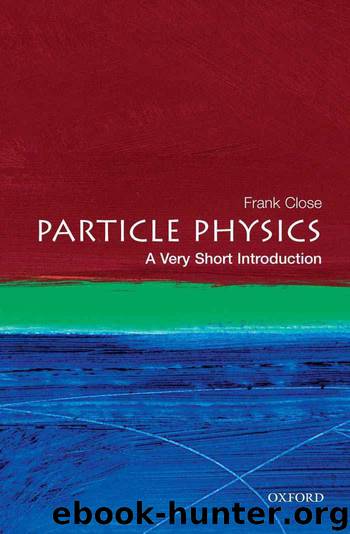Particle Physics - A Very Short Introduction by Frank Close

Author:Frank Close
Language: eng
Format: mobi
Published: 2010-10-28T17:07:08.220000+00:00
Chapter 5 Accelerators: cosmic and man-made
Cosmic rays come free of charge but are random; the need for controlled experiments leads to particle accelerators. This chapter looks at smashing beams of particles into targets in the lab and colliding beams head on, and the advantages of each. Also, beams of matter and antimatter – electrons and positrons at the Large Electron Positron (LEP) collider, protons and antiprotons, particle factories.
For a century beams of particles have been used to reveal the inner structure of atoms. These have progressed from naturally occurring alpha and beta particles, courtesy of natural radioactivity, through cosmic rays to intense beams of electrons, protons, and other particles at modern accelerators. By smashing the primary beams into a target, some of the energy can be converted into new particles, which can themselves be accumulated and made into secondary beams. Thus beams of pions and neutrinos, as well as other particles called kaons and muons, have been made, along with antiparticles such as positrons and antiprotons. There are even beams of heavy ions – atoms stripped of their electrons – which enable violent collisions between heavy nuclei to be investigated.
Different particles probe matter in complementary ways. It has been by combining the information from these various approaches that our present rich picture has emerged. Sometimes the beams are directed at static targets. In recent years there has been an increasing strategy of making counter-rotating beams of particles and antiparticles, such as electrons and positrons, or protons and antiprotons, and colliding them head on. Such techniques enable questions to be investigated that would otherwise be impossible, as we shall see later.
There has also been a renewed interest in cosmic rays, where nature provides particles at energies far beyond anything that we can contemplate achieving on Earth. The problem is that such rays come at random, and are much less intense than beams made at accelerators. It was the desire to replicate the cosmic rays under controlled conditions that led to modern high-energy physics at accelerators. Today we are recognizing that the Big Bang may have made exotic particles, far more massive than we can ever make on earth, but which might arrive in cosmic rays occasionally. We discovered strange particles (see Chapter 8) in cosmic rays, and later made them to order at accelerator experiments; there is hope that similar fortunes might await us.
Stars and supernovae emit neutrinos; special laboratories have been constructed underground to obstruct the arrival of all but the most penetrating particles, such as neutrinos. Neutrino astronomy is a new area of science that is expected to flower in the early decades of the 21st century. There are also attempts to find evidence of extremely rare events, such as the possibility that protons are not stable and decay, even with a half life that exceeds 1032 years. The technique is to have huge samples, such as swimming pool volumes of pure water. Although protons on average have such an immense life expectancy, quantum theory implies that an individual proton might live far longer, or shorter, than this.
Download
This site does not store any files on its server. We only index and link to content provided by other sites. Please contact the content providers to delete copyright contents if any and email us, we'll remove relevant links or contents immediately.
| Atomic & Nuclear Physics | Particle Physics |
The Complete Stick Figure Physics Tutorials by Allen Sarah(7338)
Secrets of Antigravity Propulsion: Tesla, UFOs, and Classified Aerospace Technology by Ph.D. Paul A. Laviolette(5333)
Thing Explainer by Randall Munroe(3909)
The River of Consciousness by Oliver Sacks(3572)
The Order of Time by Carlo Rovelli(3162)
How To by Randall Munroe(3074)
A Brief History of Time by Stephen Hawking(2992)
I Live in the Future & Here's How It Works by Nick Bilton(2960)
What If?: Serious Scientific Answers to Absurd Hypothetical Questions by Randall Munroe(2667)
The Great Unknown by Marcus du Sautoy(2662)
Midnight in Chernobyl by Adam Higginbotham(2516)
Blockchain: Ultimate Step By Step Guide To Understanding Blockchain Technology, Bitcoin Creation, and the future of Money (Novice to Expert) by Keizer Söze(2467)
Networks: An Introduction by Newman Mark(2382)
The Meaning of it All by Richard Feynman(2319)
Easy Electronics by Charles Platt(2308)
The Tao of Physics by Fritjof Capra(2247)
Midnight in Chernobyl: The Untold Story of the World's Greatest Nuclear Disaster by Adam Higginbotham(2196)
When by Daniel H Pink(2098)
Introducing Relativity by Bruce Bassett(2097)
